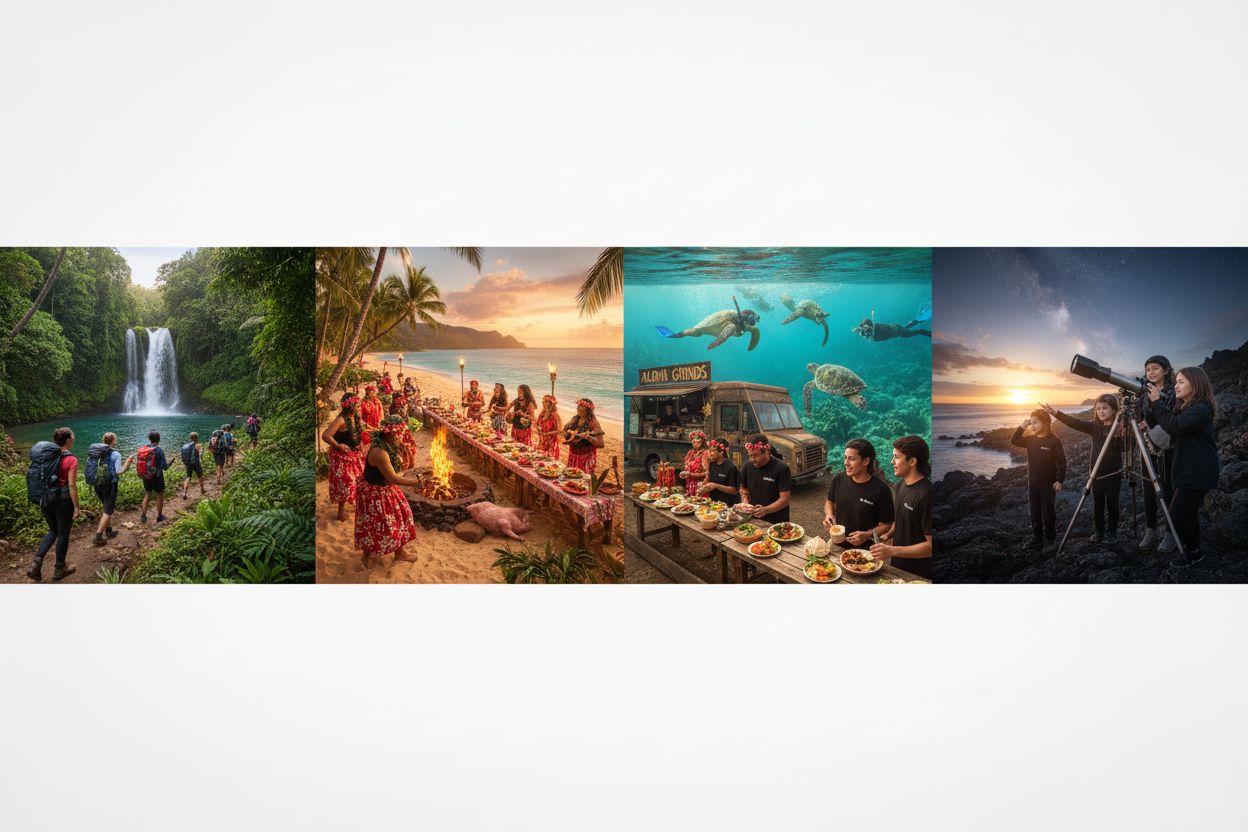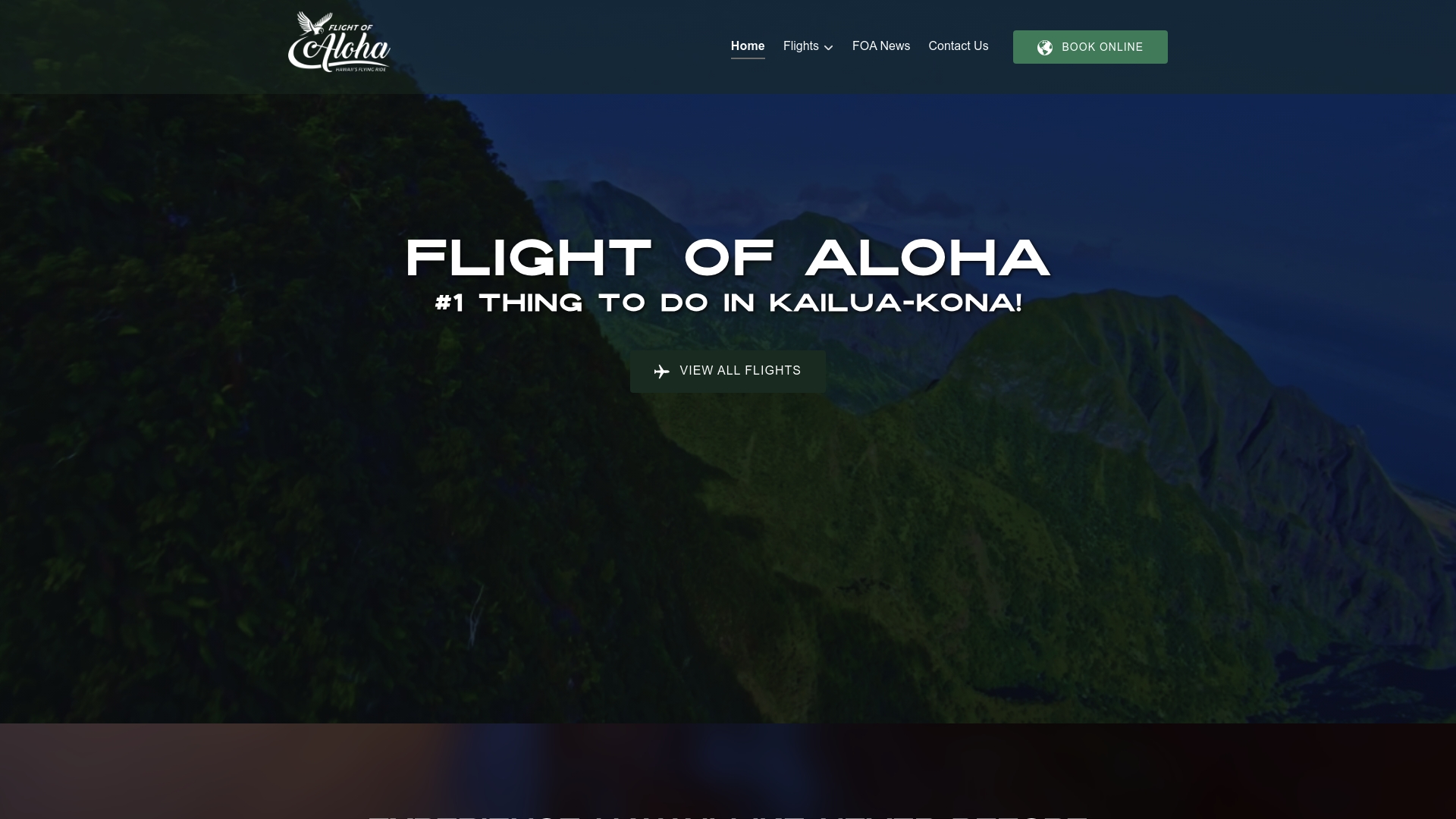7 Unique Hawaii Experiences You Can’t Miss

Hawaii’s adventures go way beyond postcard beaches. Think secret jungles where Akaka Falls plunges 442 feet through rainforest, centuries-old dances that double as living stories, and food truck festivals packed with flavors from all over the Pacific. You might expect this to be a checklist for only thrill seekers or outdoor pros. Turns out, these unforgettable Hawaiian experiences are open to anyone ready for something truly out of the ordinary—if you know where to look.
Table of Contents
- Discover Hidden Waterfalls In The Jungle
- Attend A Traditional Hawaiian Luau
- Explore The Art Of Hula Dancing
- Snorkel With Sea Turtles In Protected Bays
- Experience Stargazing From Mauna Kea
- Sample Local Cuisine At A Food Truck Festival
- Learn About Hawaiian History At National Parks
Quick Summary
| Takeaway | Explanation |
|---|---|
| Prepare for hidden waterfall hikes | Wear sturdy shoes, carry water, and use GPS for safe explorations. |
| Attend authentic Hawaiian luaus | Choose luaus that prioritize cultural storytelling and traditional foods for a genuine experience. |
| Respect marine life while snorkeling | Maintain distance from sea turtles and use reef-safe sunscreen to protect the environment. |
| Experience hula as cultural storytelling | Engage with hula through performances or workshops to understand its historical significance and artistry. |
| Explore national parks for Hawaiian history | Learn about geology and culture by visiting parks that highlight Hawaii’s unique landscapes and traditions. |
1: Discover Hidden Waterfalls in the Jungle
Hawaii offers some of the most breathtaking and secluded waterfall experiences in the world, transforming a simple hike into an unforgettable adventure through lush tropical landscapes. The Hawaiian islands are home to dozens of hidden waterfalls tucked away in dense rainforest environments, each offering a unique and mesmerizing encounter with nature’s raw beauty.
Navigating these hidden waterfalls requires preparation and respect for the natural environment. National Geographic highlights that many of these waterfalls are located in remote areas that demand careful exploration. Adventurers should consider several key preparation strategies:
- Wear sturdy hiking shoes with excellent traction
- Bring plenty of water and lightweight, quick-drying clothing
- Pack waterproof gear to protect electronics
- Carry a reliable GPS or hiking map
The Hawaiian islands feature remarkable waterfall diversity, ranging from towering 400-foot cascades to intimate, secluded drops hidden within dense vegetation. On the island of Maui, Waimoku Falls stands as a spectacular example, plunging 400 feet down volcanic rock faces in Haleakala National Park. Big Island offers equally stunning options like Akaka Falls, which drops 442 feet through a verdant rainforest setting.
For those seeking truly unique hawaii experiences, waterfall exploration represents more than just a visual spectacle. It’s an immersive journey into the heart of Hawaiian wilderness, where each step reveals intricate ecosystems, native plant species, and the powerful geological history that shaped these remarkable landscapes. U.S. Forest Service notes that these environments are not just scenic backdrops but complex, interconnected natural systems that require careful, respectful interaction.
Whether you’re an experienced hiker or a casual nature enthusiast, discovering hidden waterfalls promises an extraordinary connection with Hawaii’s untamed natural world. The journey itself becomes as memorable as the destination, offering glimpses into the raw, unfiltered beauty that makes Hawaiian landscapes truly extraordinary.
2: Attend a Traditional Hawaiian Luau
A traditional Hawaiian luau represents far more than just a meal – it’s a profound cultural celebration that connects visitors directly to the heart of Hawaiian heritage. These vibrant gatherings transform an ordinary evening into an immersive experience of music, dance, food, and storytelling that captures the essence of island culture.
Smithsonian Magazine explains that luaus trace their roots back to ancient Hawaiian gatherings called “aha’aina,” where communities would come together to share food and mark significant life events. Modern luaus have evolved while maintaining deep cultural significance.
Visitors can expect a sensory journey that encompasses multiple elements of Hawaiian tradition:
- Authentic kalua pork slow-roasted in underground ovens
- Traditional hula dance performances
- Live musical performances featuring ukulele and traditional instruments
- Colorful costumes representing different Polynesian cultures
Authentic luaus offer more than entertainment – they provide a window into Hawaiian cultural practices. Learn more about Hawaiian cultural experiences that complement the luau tradition and provide deeper insights into island heritage.
Choosing the right luau matters. Some experiences focus more on theatrical performance, while others prioritize genuine cultural education. The Big Island and Maui offer particularly renowned luau experiences, with venues that range from beachfront resorts to historic plantation sites.
Key considerations for selecting an authentic luau include understanding the performers’ backgrounds, the quality of traditional food preparation, and the depth of cultural storytelling. Prices typically range from $90 to $200 per person, with premium experiences offering more intimate settings and deeper cultural narratives.
A true Hawaiian luau is not just a tourist attraction – it’s a living, breathing celebration of community, history, and the profound spirit of aloha that defines Hawaiian culture. Each performance tells a story, each dish carries historical significance, and every moment invites visitors to connect with the rich tapestry of island traditions.
3: Explore the Art of Hula Dancing
Hula dancing represents far more than a simple performance – it is a profound storytelling art form that communicates Hawaiian history, mythology, and cultural traditions through intricate movements and gestures. This ancient practice transforms physical motion into a powerful narrative language that connects generations and preserves indigenous knowledge.
Polynesian Cultural Center reveals that hula originated as a spiritual practice with deep religious significance, where dancers would communicate sacred stories and honor Hawaiian deities. Modern hula has evolved while maintaining its core cultural essence, bridging traditional practices with contemporary interpretations.
Two primary styles of hula exist, each offering unique perspectives on Hawaiian cultural expression:
- Hula Kahiko: Traditional, ancient style performed with chants and percussion
- Hula Auana: Modern style incorporating contemporary music and Western instruments
Learning hula requires dedication and respect. Dancers undergo rigorous training that extends far beyond physical movements, encompassing language, history, and spiritual understanding. Hawaiian language plays a crucial role, with each gesture carefully choreographed to translate poetic lyrics and historical narratives.
Discover more about Hawaiian cultural storytelling to understand the deeper context of performative arts like hula. These experiences reveal how movement becomes a powerful medium of cultural preservation.
Visitors can engage with hula through various experiences: watching professional performances, attending workshops, or participating in cultural festivals. The Big Island and Oahu offer exceptional opportunities to witness authentic hula performances that showcase the nuanced artistry of this remarkable dance form.
Beyond entertainment, hula represents a living, breathing connection to Hawaiian heritage. Each movement tells a story, each gesture carries historical significance, and every performance invites observers to understand the profound cultural wisdom embedded in this extraordinary art form. Hula is not just a dance – it is a vibrant, dynamic language of cultural memory and spiritual expression.
4: Snorkel with Sea Turtles in Protected Bays
Snorkeling with sea turtles offers one of the most magical marine encounters in Hawaii, transforming an ordinary underwater exploration into an extraordinary wildlife experience. These ancient marine creatures, known locally as honu, represent more than just a tourist attraction – they are sacred beings deeply respected in Hawaiian culture and marine ecosystems.
National Oceanic and Atmospheric Administration documents that Hawaiian green sea turtles are protected under the Endangered Species Act, making their preservation and respectful observation critically important. Swimmers must maintain a careful distance and follow strict guidelines to protect these remarkable animals.
Before embarking on a sea turtle snorkeling adventure, consider these essential preparation tips:
- Wear reef-safe sunscreen to protect marine environments
- Bring underwater camera with zoom capabilities
- Rent high-quality snorkeling equipment from local vendors
- Pack water and hydration supplies
Hawaii’s protected bays offer exceptional locations for these encounters. The Big Island’s Punalu’u Black Sand Beach and Maui’s Molokini Crater are renowned for consistent sea turtle sightings. Learn more about unique Hawaiian marine experiences to understand the deeper cultural significance of these marine interactions.
Understanding sea turtle behavior enhances the snorkeling experience. Honu are generally peaceful creatures that glide effortlessly through coral reefs, grazing on seagrass and algae. Observers might witness fascinating behaviors like synchronized swimming or turtles resting on underwater rock formations.
Ethical wildlife interaction remains paramount. Swimmers should maintain a minimum six-foot distance, avoid touching or chasing turtles, and move slowly and calmly to prevent disrupting their natural behaviors. These guidelines ensure both human safety and marine wildlife protection.
Snorkeling with sea turtles transcends a simple tourist activity – it becomes a profound connection with Hawaii’s vibrant marine ecosystem. Each underwater moment offers a glimpse into a world of incredible beauty, reminding visitors of the delicate balance and extraordinary life thriving beneath the ocean’s surface.
5: Experience Stargazing from Mauna Kea
Mauna Kea stands as a celestial sanctuary, offering one of the most extraordinary stargazing experiences on the planet. Rising 13,803 feet above sea level, this dormant volcano provides an unparalleled astronomical observatory where visitors can witness the universe with breathtaking clarity and profound wonder.
NASA confirms that Mauna Kea’s unique geographical location and atmospheric conditions make it one of the world’s premier astronomical research sites. The mountain’s high altitude, minimal light pollution, and stable atmospheric conditions create an ideal environment for both scientific observation and amateur stargazing.
Before embarking on a Mauna Kea stargazing adventure, consider these critical preparation guidelines:
- Dress in warm, layered clothing (temperatures can drop below freezing)
- Bring oxygen supplements for high-altitude adjustment
- Rent or bring high-powered binoculars or telescopes
- Schedule visits during new moon periods for optimal visibility
The summit hosts 13 international astronomical research telescopes, representing a global collaboration of scientific exploration. Discover more about unique Hawaiian cultural experiences that connect scientific wonder with indigenous perspectives.
Indigenous Hawaiian culture views Mauna Kea as a sacred landscape, not just an astronomical site. Native Hawaiians consider the mountain a spiritual realm connecting earth and sky, adding profound cultural significance to the astronomical experience. Visitors should approach the site with deep respect for both its scientific and cultural importance.
Stargazing tours typically offer guided experiences that combine scientific explanation with cultural storytelling. Visitors can observe celestial wonders like the Milky Way, distant galaxies, planets, and meteor showers with unprecedented clarity. Professional astronomers often lead these tours, providing insights into cosmic phenomena and the unique characteristics of Hawaiian night skies.
Experiencing Mauna Kea transcends typical tourism – it becomes a transformative journey connecting human curiosity with the infinite expanse of the universe. Each glance into the night sky offers a humbling reminder of our place in the vast, magnificent cosmic landscape.
6: Sample Local Cuisine at a Food Truck Festival
Hawaiian food truck festivals represent a vibrant culinary landscape where traditional flavors merge with innovative cooking techniques, offering visitors an authentic taste of island cuisine. These mobile kitchens transform street food into a dynamic cultural experience that goes far beyond simple dining.
Eater highlights that Hawaiian food trucks showcase the remarkable diversity of the islands’ culinary heritage, blending Polynesian, Asian, and American influences into unique gastronomic creations. These festivals are not just about eating – they’re about understanding cultural fusion through food.
Visitors should prepare for an extraordinary culinary adventure by considering these essential tips:
- Bring cash for smaller vendors
- Arrive early to sample most diverse offerings
- Pace yourself and share dishes to try more varieties
- Stay hydrated in outdoor festival settings
The Big Island and Oahu host some of the most remarkable food truck festivals, featuring an incredible array of dishes that tell stories of cultural migration and local innovation. Learn more about Hawaiian cultural experiences that connect food with deeper cultural narratives.
Staple dishes visitors might encounter include poke bowls, kalua pork, spam musubi, and malasadas – each representing a different cultural influence. Korean, Japanese, Filipino, and Portuguese culinary traditions have significantly shaped Hawaiian street food, creating a unique gastronomic ecosystem that reflects the islands’ multicultural history.
Beyond taste, these food truck festivals offer immersive experiences where visitors can interact directly with local chefs, understand cooking techniques, and hear stories behind each dish. The informal, communal atmosphere encourages cultural exchange and provides insights into Hawaii’s rich culinary traditions.
Sampling local cuisine at a food truck festival transcends mere eating – it becomes a sensory journey through Hawaiian cultural history. Each bite represents a story, each flavor a testament to the islands’ incredible culinary diversity and creative spirit.
7: Learn About Hawaiian History at National Parks
Hawaii’s national parks offer far more than scenic landscapes – they are living museums that preserve profound cultural narratives and geological wonders, providing visitors with immersive journeys through the islands’ complex historical and natural heritage.
National Park Service documents that Hawaiian national parks represent unique ecosystems where geological processes, cultural traditions, and environmental conservation intersect. These protected spaces tell stories spanning millions of years of volcanic activity and human settlement.
Visitors planning to explore Hawaiian national parks should consider these essential preparation strategies:
- Bring comfortable hiking shoes
- Pack sufficient water and sun protection
- Reserve guided tour options in advance
- Learn basic Hawaiian cultural protocols
Hawaii hosts several remarkable national parks, each offering distinctive historical insights. Hawai’i Volcanoes National Park stands out as a premier destination, showcasing active volcanic landscapes where visitors can witness ongoing geological transformations. Explore more unique Hawaiian travel experiences to complement your national park adventure.
The Haleakalā National Park on Maui provides another extraordinary historical landscape, featuring volcanic crater formations and unique alpine desert ecosystems. These parks are not just tourist destinations but sacred spaces where indigenous Hawaiian cultural practices and natural preservation intersect.
Understanding Hawaiian history through national parks involves recognizing the profound connection between landscape, culture, and spiritual practices. Native Hawaiians have long viewed these environments as living entities, with volcanic formations representing dynamic, transformative forces rather than static geological features.
Learning about Hawaiian history at national parks transcends traditional tourism. Each step reveals layers of geological complexity, cultural resilience, and environmental adaptation. Visitors walk through landscapes that tell stories of volcanic eruptions, ecological transformation, and human interaction with an ever-changing natural world.
Below is a comprehensive table summarizing the 7 unique Hawaii experiences covered in the article, including key points, what to expect, and main benefits for travelers.
| Experience | What to Expect | Main Benefit |
|---|---|---|
| Hidden Waterfalls in the Jungle | Hike to secluded waterfalls like Akaka and Waimoku Falls; lush rainforest scenery; requires preparation | Adventure, nature immersion, view unique geological sites |
| Traditional Hawaiian Luau | Authentic food (kalua pork), hula, music, storytelling; community atmosphere | Cultural connection, local cuisine, heritage celebration |
| Art of Hula Dancing | Watch or join performances/workshops; learn about kahiko/auana styles and symbolic gestures | Deep insight into Hawaiian traditions and storytelling |
| Snorkel with Sea Turtles in Protected Bays | Observe honu in places like Punalu’u or Molokini; practice ethical marine wildlife interaction | Unique wildlife encounter, supports conservation |
| Stargazing from Mauna Kea | Tours at summit observatory; clear views of night sky; scientific and cultural narratives | Awe-inspiring astronomy, respect for sacred landscapes |
| Local Cuisine at Food Truck Festivals | Food truck tastings on Big Island/Oahu; flavors blend Polynesian, Asian, American traditions | Culinary adventure, multicultural local insights |
| Hawaiian History at National Parks | Visit places like Hawai’i Volcanoes and Haleakalā; guided tours; focus on geology and culture | Rich historical context, scenic exploration, heritage sites |
Bring Hawaii’s Wonders to Life at Flight of Aloha
Craving the thrill of discovering hidden waterfalls, connecting with sacred wildlife, and exploring authentic Hawaiian culture, but unsure how to experience it all in a single visit? The article highlights the challenges of limited time, physical difficulty, or access barriers that keep many travelers from truly immersing themselves in every aspect of Hawaii’s beauty—both natural and cultural. At Flight of Aloha, you can soar above lush jungles, sweep over volcanic landscapes, and witness the rich traditions of the islands—all through our cutting-edge flying theater right in Kailua-Kona.

Want to witness everything from breathtaking waterfalls to ancient legends without the crowds or long hikes? Visit Flight of Aloha and book your immersive ride today. Our attraction brings the island’s most iconic experiences to you in stunning 8K detail with motion seats, wind, and scents—there is no other “Kailua Kona thing to do” quite like it. Secure your tickets now and discover why a visit to Flight of Aloha is the perfect adventure for families, groups, and explorers seeking an unforgettable taste of Hawaii’s spirit. You can also browse our exclusive ride films and package details directly on the Flight of Aloha homepage to plan your visit.
Frequently Asked Questions
What are some hidden waterfalls in Hawaii worth visiting?
Hawaii is home to numerous hidden waterfalls, including Waimoku Falls and Akaka Falls. Each offers a unique experience amidst stunning natural landscapes.
What should I bring to a traditional Hawaiian luau?
For a traditional Hawaiian luau, consider wearing comfortable clothing, bringing a camera, and being prepared to enjoy authentic food and cultural performances.
How can I ethically snorkel with sea turtles in Hawaii?
To snorkel ethically with sea turtles, maintain a minimum six-foot distance, avoid touching or chasing them, and use reef-safe sunscreen to protect their habitat.
What makes Mauna Kea a great stargazing location?
Mauna Kea’s high altitude, minimal light pollution, and stable atmospheric conditions provide an exceptional environment for stargazing, allowing for clear views of celestial wonders.
